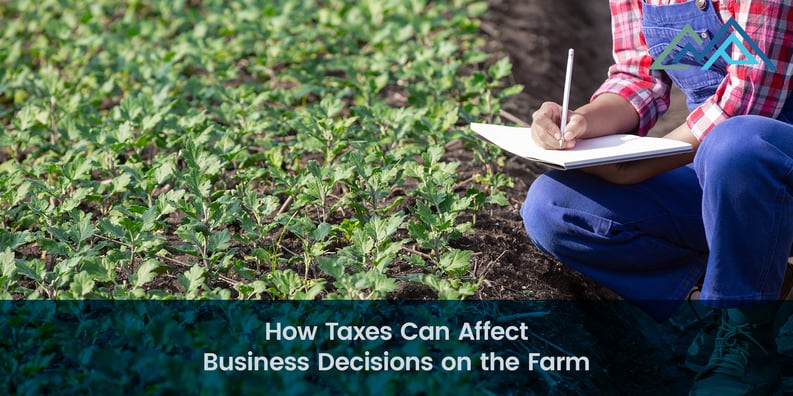Every farmer knows that the decisions they make on the farm can have a big impact on everything from their bottom line to the amount of taxes they pay. It’s one of the reasons that running a farm can be just as complicated as running any other business.

At CMP, we understand the challenges that farmers face. We work closely with our farming clients to help them understand how their daily business impacts their taxes – and what they can do to reduce their tax burden.
With that in mind, here are some things that may help you understand how taxes can affect your business decisions on the farm.
Inventory
You have two choices when it comes to how you inventory your livestock, and each can impact your taxes.
The first inventory method is the farm-price method. It allows farmers to evaluate their inventories at market prices, less the direct cost of disposition.
The other option is the unit-livestock-price method. This method requires you to classify your livestock into groups based on age and kind. Then, you’ll establish a price for each class, including the normal cost of raising the animals.
Both methods set you up for a lower tax rate on future capital gains from the sale of livestock. The latter method requires you to reevaluate unit prices each year and adjust them based on changes in the costs of raising livestock.
Research Tax Credits
The Internal Revenue Service offers tax incentives to businesses in a variety of areas. If you sometimes experiment with different farming methods, equipment, or fertilizers, you may be able to qualify for the Research & Development Tax Credit.
Research & Development must be new technology or new methods for products or methods used on the farm or ranch. There must be a process of experimentation in which the outcome cannot be predicted. The product or process must not already exist on the open market. While many farmers and agricultural companies do not take advantage of the R & D tax credit, it’s possible that the work you’re already doing could qualify you to take it.
Purchasing
Every year, farmers buy supplies they need to grow crops, raise livestock, and earn a profit. These may include things like:
- Animal feed
- Chemicals
- Fertilizer
- Fuel
- Seeds
In a high-income year, it may make sense to stock up on some items if it lowers your tax burden. The key is to make sure you’ll use what you buy in the coming year, and that any purchases you make are directly related to your farming business.
You may also decide to invest in a costly piece of equipment at the end of the tax year. That’s because Section 179 of the tax code allows farmers to take a larger-than-normal depreciation deduction in the year of purchase.
Depreciation or Inventory of Livestock
When you begin farming operations, you must decide whether you will depreciate your livestock or hold it in inventory. Livestock that you hold primarily for sale must be included in inventory. But, livestock that you use for breading or production of the product you sell like steers or heifers you must depreciate.
The key difference is when depreciating your livestock, you’ll receive a depreciation deduction currently instead of waiting until you the livestock is sold. However, you should be aware that this option decreases your basis in the livestock and increases any gain (and tax on that gain) when you sell the livestock. Any profits on the sale of depreciated livestock are taxed at ordinary tax rates.
By contrast, if you choose to inventory your livestock, you’ll forego the current depreciation deduction entirely. The good news is that any future capital gain on the sales of the livestock will be taxed at the lower capital gains tax rate instead of the higher ordinary tax rate.
Construction
It’s very common for farmers to have structures on their farms that need to be rebuilt. These may include equipment barns, animal holding facilities, single-purpose buildings like a diary barn, and machine shops.
In some cases, you may be able to deduct the entire cost of construction on your taxes. If you decide to use construction to reduce your taxes, keep in mind that there are differences in cost recovery:
- For equipment barns and machine shops, costs may be recovered over 20 years
- For chicken houses, grain bins, livestock barns, and silos, the costs may be recovered over 10 years
If you have questions about how construction will affect your taxes, consult an experienced accountant before you begin.
Gain on Sales
Livestock sales must be reported to the IRS on Form 4797, Sales of Business Property. The calculation of the sales gain is dependent upon whether you raised the animals or purchased them. The tax rate you pay on the gain of sales will depend on whether you decide to depreciate or inventory your livestock, as mentioned above.
For livestock that you raised, the gain is calculated as the difference between your selling expenses and the gross sales price. This method assumes the basis is zero because you would have deducted the costs of raising the livestock for every year that you raised it.
Sales gains for livestock that you purchased are handled differently. You can calculate it by taking the gross sales price and subtracting the adjusted basis and selling expenses.
The treatment of the sales gain is dependent on whether the property is qualified under Section 1231(b)(3) as property used in trade or business. To qualify, the livestock must be held by you for breeding, dairy, draft, or sporting purposes for at least 12 months (24 months for cattle and horses.)
If you do qualify under Section 1231 for your raised livestock then there is great news. The gain will be considered a capital gain. Capital gain tax rates are always less than ordinary income rates. Your gain should be reported on Part III of Form 4797. Otherwise, the gain or loss should be reported on Part I.
Payments to Dependent Children
If you have your dependent children pitch in on the farm and help with chores related to your business, it may be worthwhile to pay them for their efforts in return for a break on your taxes.
The Tax Cuts and Jobs Act of 2018 increased the amount of money that children under the age of 18 can be exempt from federal income taxes. In fact, it nearly doubled.
That means you can pay your children to work. Provided that the amount you pay them is equal to or less than the exemption amount, they can take the money tax-free and put it into a Roth IRA or a college savings account. If your farm or ranch is organized as a sole proprietorship or a husband/wife partnership you won’t be required to withhold payroll taxes and you’ll reduce your tax burden while helping your kids plan for their futures.
CMP is Ready to Help Structure Your Farm Taxes Today
You make decisions every day on behalf of your farming business, and it’s important to know how they will affect your taxes in the current year and in the future. You can use the information we’ve included here to make smarter decisions and minimize the amount you end up paying in federal taxes.
Need help with your farm taxes? Reach out to CMP to learn more about our Farm & Ranch Accounting and Tax Services or click the button below.

















